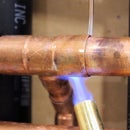Introduction: How to Install a NON-FREEZING Outdoor Hydrant
What’s up everyone, in this article and video I’ll be explaining how to install a NON-FREEZING outdoor water hydrant the correct way.
Step 1: Why Make the Switch?
Alright, so as you could see here, I have an ordinary drain-cock type of water hydrant in my backyard and I’ll be replacing it with a non-freezing, ¼” turn water hydrant like this right here.
Let me start by telling you why you want to replace your typical drain cock hydrant with one of these if you live in a country with a cold climate like Canada.
When it starts getting cold outside, in order to keep your pipes from bursting inside the house, you need to isolate any pipe that is in direct contact with the cold temperature inside, in order to keep your pipes from freezing with a valve like this one here.
The disadvantage of having a setup like this is that you can potentially forget to close it when it starts getting cold and have a pipe burst inside the house, causing thousands in water damage.
Step 2: How Does It Work?
This type of water hydrant eliminates that factor by closing the water supply inside the house every time it’s closed at the exterior using a rod type stem as such, which is a very clever idea.
This hydrant also has an anti-siphoning feature which allows water out but not back in, so let’s say you have a water hose in the grass where there’s dirt and other contaminants and the city decides to cut the water off for maintenance work and creates a vacuum, nothing will be sucked into your potable water system, which is also a nice feature.
So let’s go ahead and install it.
Step 3: Start by Closing the Main Water Valve
The first thing that needs to be done, is to close the main water valve to the house, or any nearby valve that’ll isolate where the work is being done. Let any remaining pressure in the system out by opening a tap or use the existing hydrant outside.
Step 4: Remove the Existing Isolation Valve
After, you’ll need to remove the existing valve, I basically cut mine here and pulled it out from outside and it came right out.
Next, since I’ll be converting into PEX piping, we’ll be installing a female adaptor on now as it’ll be much easier than if done when the hydrant is installed. So get yourself some Teflon tape and wrap it around in a clock-wise direction, as if you put it on the other way, when tightening your fitting, it’ll tend to wanna come off and might eventually leak. Then, if you have some on hand, apply a bit of pipe dope on the Teflon to remove any chances of having a small leak, I’ve always done this and I’ve never had any leaks.
While I am at it, I’ll also crimp on a piece of pipe to make sure I’ll have access to the crimp ring if ever it’s too close to the wall.
Here’s a neat little trick when crimping a fitting. Grab a pair of pliers and gently crimp it so it stays in position when doing the final crimp. These tend to move when using a crimp tool and could get quite annoying, so this little trick makes it that much easier.
With the valve all dressed up and ready to be installed, let’s take a look at what needs to be done inside.
Step 5: The Female Adaptor
Since we are transferring to PEX, I’ll need to install a copper to PEX adaptor.
Seeing I won’t be needing the valve that was used to isolate my exterior hydrant anymore, let’s remove it and solder on the copper to pex adaptor. Now, even if these aren’t meant for drinking water, you absolutely need to solder with lead-free solder for the installation to be up to code.
So go ahead and solder of the adaptor, and wait for it to cool before attempting to connect a plastic pipe on it.
While that cools down, we’ll install the actual hydrant.
Step 6: Mishaps!
So I had a little mishap when going to install the new hydrant, seeing it's 1" in diameter, it wouldn't fit in the existing hole. I tried opening up the hole a little bit with a steel pipe and a mallet, but to my deception, it didn't work out.
So I went to my local rent-a-tool shop and got myself a rotary hammer drill with a 1" SDS-MAX bit and it drilled right thru. I then inserted the hydrant and it took a little fiddling but I went it.
Step 7: Gotta Have That Slope
Now, when installing a non-freeze hydrant like this, there must be a slight slope towards the exterior to let all the water out when closing it. This is what differs from an incorrect installation to a correct one. To accomplish this, I basically use a small wooden shim and tuck it under the valve as such to give it that slight slope.
Step 8: Securing That Hydrant
Once that was done, I drilled 2 small holes using a masonry bit, and fastened it with 2 stainless steel screws just to make sure they don’t rust and break down in time.
Step 9: Sealing
I suggest using some exterior silicone to cover the joint so that critters and cold air don’t enter the house.
Step 10: Final Connections
Back to the inside. The only things left to do are to make the final connections and test everything out for any possible leaks.
Now we could see why I assembled everything together before installing it, it would have been a lot harder to do so now due to the lack of space.
So go ahead and install your pipe, crimp your fittings and you’re done! Let’s turn the main water valve back on and test everything out, and as you could see, there aren’t any leaks which is exactly what your looking for.
Step 11: Testing
Let’s turn the main water valve back on and test everything out, and as you could see, there aren’t any leaks which is exactly what your looking for. And here it is in action, I love the quarter turn feature compared to other models that take forever to close. I did pay a little extra for this but hey, it’s well worth it.
Step 12: Remove Any Hose for Winter
The last tip I have to give is, whenever closing the valve for winter, remove any hose that’s attached to it, this is very important, or some water will stay in the valve and damage it eventually.




